Administrative law - Assignment pdf
VerifiedAdded on 2021/05/31
|16
|5556
|143
AI Summary
Contribute Materials
Your contribution can guide someone’s learning journey. Share your
documents today.
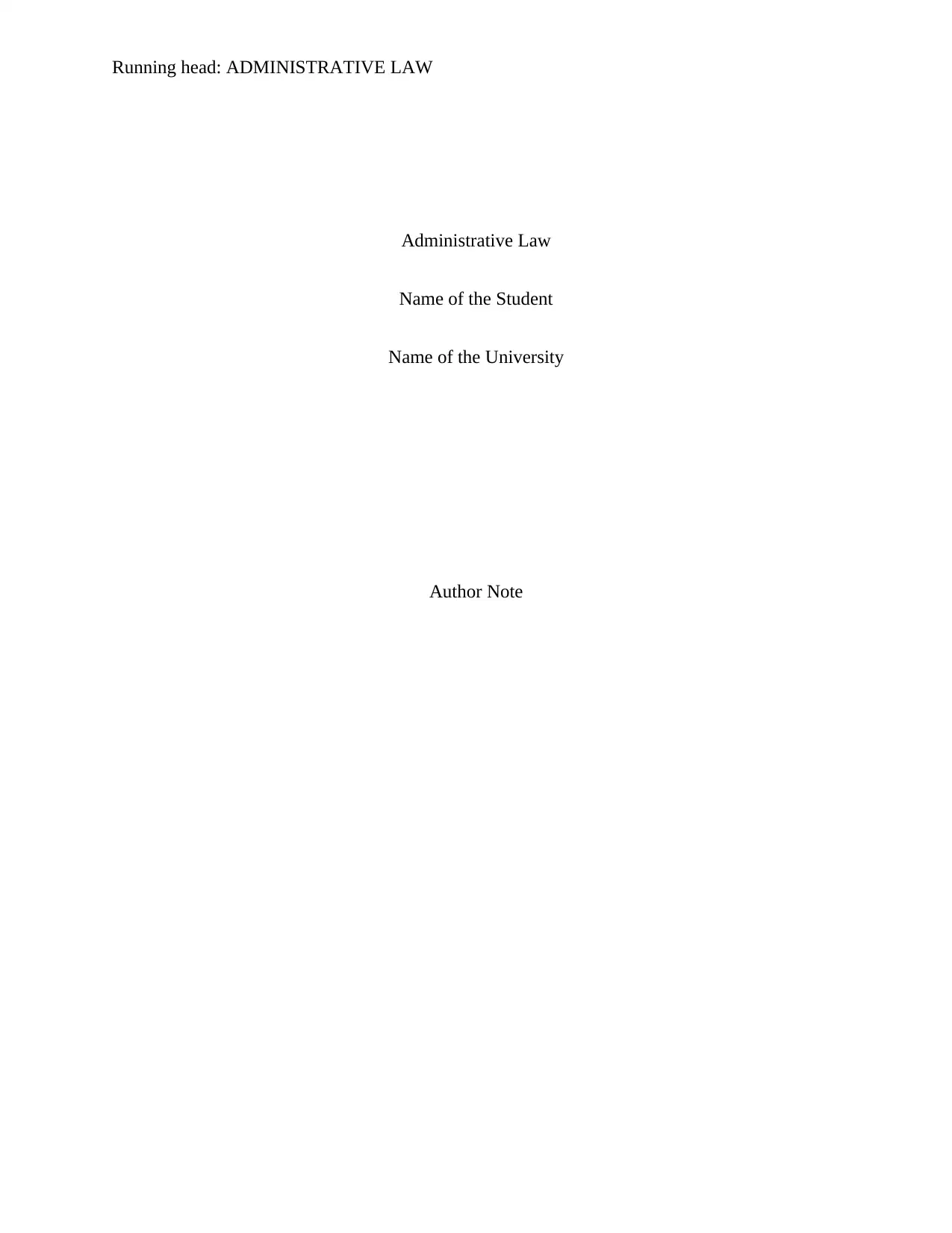
Running head: ADMINISTRATIVE LAW
Administrative Law
Name of the Student
Name of the University
Author Note
Administrative Law
Name of the Student
Name of the University
Author Note
Secure Best Marks with AI Grader
Need help grading? Try our AI Grader for instant feedback on your assignments.
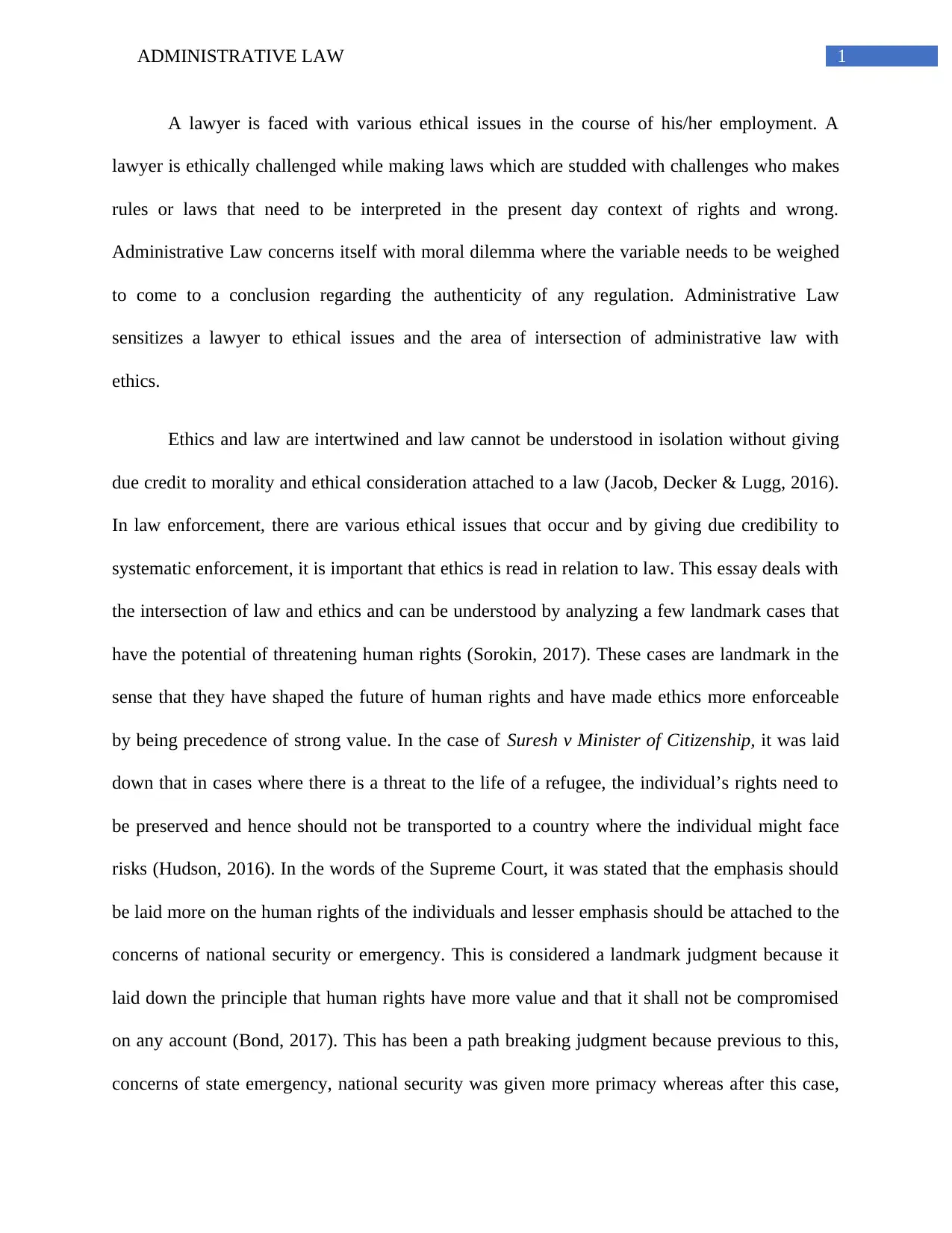
1ADMINISTRATIVE LAW
A lawyer is faced with various ethical issues in the course of his/her employment. A
lawyer is ethically challenged while making laws which are studded with challenges who makes
rules or laws that need to be interpreted in the present day context of rights and wrong.
Administrative Law concerns itself with moral dilemma where the variable needs to be weighed
to come to a conclusion regarding the authenticity of any regulation. Administrative Law
sensitizes a lawyer to ethical issues and the area of intersection of administrative law with
ethics.
Ethics and law are intertwined and law cannot be understood in isolation without giving
due credit to morality and ethical consideration attached to a law (Jacob, Decker & Lugg, 2016).
In law enforcement, there are various ethical issues that occur and by giving due credibility to
systematic enforcement, it is important that ethics is read in relation to law. This essay deals with
the intersection of law and ethics and can be understood by analyzing a few landmark cases that
have the potential of threatening human rights (Sorokin, 2017). These cases are landmark in the
sense that they have shaped the future of human rights and have made ethics more enforceable
by being precedence of strong value. In the case of Suresh v Minister of Citizenship, it was laid
down that in cases where there is a threat to the life of a refugee, the individual’s rights need to
be preserved and hence should not be transported to a country where the individual might face
risks (Hudson, 2016). In the words of the Supreme Court, it was stated that the emphasis should
be laid more on the human rights of the individuals and lesser emphasis should be attached to the
concerns of national security or emergency. This is considered a landmark judgment because it
laid down the principle that human rights have more value and that it shall not be compromised
on any account (Bond, 2017). This has been a path breaking judgment because previous to this,
concerns of state emergency, national security was given more primacy whereas after this case,
A lawyer is faced with various ethical issues in the course of his/her employment. A
lawyer is ethically challenged while making laws which are studded with challenges who makes
rules or laws that need to be interpreted in the present day context of rights and wrong.
Administrative Law concerns itself with moral dilemma where the variable needs to be weighed
to come to a conclusion regarding the authenticity of any regulation. Administrative Law
sensitizes a lawyer to ethical issues and the area of intersection of administrative law with
ethics.
Ethics and law are intertwined and law cannot be understood in isolation without giving
due credit to morality and ethical consideration attached to a law (Jacob, Decker & Lugg, 2016).
In law enforcement, there are various ethical issues that occur and by giving due credibility to
systematic enforcement, it is important that ethics is read in relation to law. This essay deals with
the intersection of law and ethics and can be understood by analyzing a few landmark cases that
have the potential of threatening human rights (Sorokin, 2017). These cases are landmark in the
sense that they have shaped the future of human rights and have made ethics more enforceable
by being precedence of strong value. In the case of Suresh v Minister of Citizenship, it was laid
down that in cases where there is a threat to the life of a refugee, the individual’s rights need to
be preserved and hence should not be transported to a country where the individual might face
risks (Hudson, 2016). In the words of the Supreme Court, it was stated that the emphasis should
be laid more on the human rights of the individuals and lesser emphasis should be attached to the
concerns of national security or emergency. This is considered a landmark judgment because it
laid down the principle that human rights have more value and that it shall not be compromised
on any account (Bond, 2017). This has been a path breaking judgment because previous to this,
concerns of state emergency, national security was given more primacy whereas after this case,
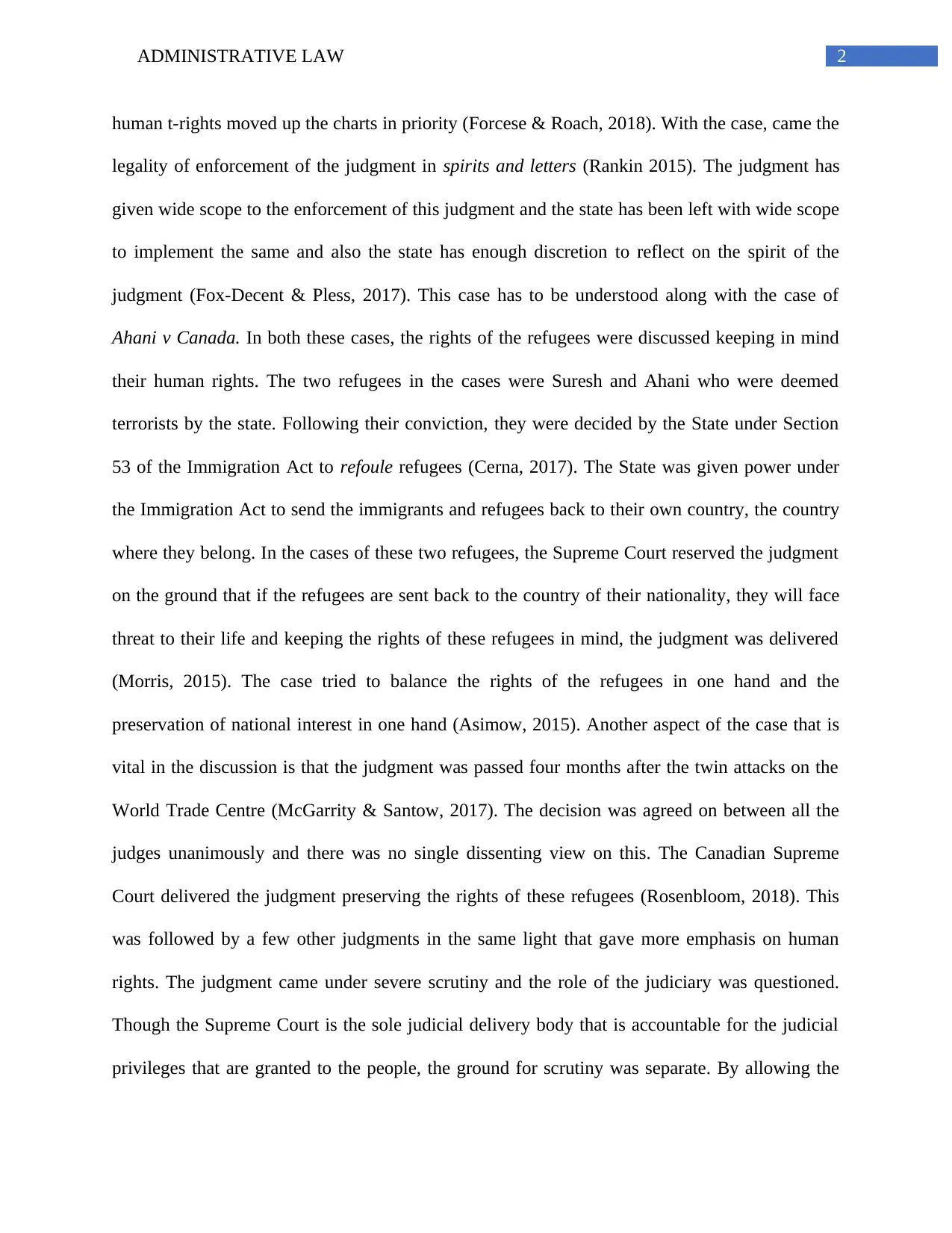
2ADMINISTRATIVE LAW
human t-rights moved up the charts in priority (Forcese & Roach, 2018). With the case, came the
legality of enforcement of the judgment in spirits and letters (Rankin 2015). The judgment has
given wide scope to the enforcement of this judgment and the state has been left with wide scope
to implement the same and also the state has enough discretion to reflect on the spirit of the
judgment (Fox-Decent & Pless, 2017). This case has to be understood along with the case of
Ahani v Canada. In both these cases, the rights of the refugees were discussed keeping in mind
their human rights. The two refugees in the cases were Suresh and Ahani who were deemed
terrorists by the state. Following their conviction, they were decided by the State under Section
53 of the Immigration Act to refoule refugees (Cerna, 2017). The State was given power under
the Immigration Act to send the immigrants and refugees back to their own country, the country
where they belong. In the cases of these two refugees, the Supreme Court reserved the judgment
on the ground that if the refugees are sent back to the country of their nationality, they will face
threat to their life and keeping the rights of these refugees in mind, the judgment was delivered
(Morris, 2015). The case tried to balance the rights of the refugees in one hand and the
preservation of national interest in one hand (Asimow, 2015). Another aspect of the case that is
vital in the discussion is that the judgment was passed four months after the twin attacks on the
World Trade Centre (McGarrity & Santow, 2017). The decision was agreed on between all the
judges unanimously and there was no single dissenting view on this. The Canadian Supreme
Court delivered the judgment preserving the rights of these refugees (Rosenbloom, 2018). This
was followed by a few other judgments in the same light that gave more emphasis on human
rights. The judgment came under severe scrutiny and the role of the judiciary was questioned.
Though the Supreme Court is the sole judicial delivery body that is accountable for the judicial
privileges that are granted to the people, the ground for scrutiny was separate. By allowing the
human t-rights moved up the charts in priority (Forcese & Roach, 2018). With the case, came the
legality of enforcement of the judgment in spirits and letters (Rankin 2015). The judgment has
given wide scope to the enforcement of this judgment and the state has been left with wide scope
to implement the same and also the state has enough discretion to reflect on the spirit of the
judgment (Fox-Decent & Pless, 2017). This case has to be understood along with the case of
Ahani v Canada. In both these cases, the rights of the refugees were discussed keeping in mind
their human rights. The two refugees in the cases were Suresh and Ahani who were deemed
terrorists by the state. Following their conviction, they were decided by the State under Section
53 of the Immigration Act to refoule refugees (Cerna, 2017). The State was given power under
the Immigration Act to send the immigrants and refugees back to their own country, the country
where they belong. In the cases of these two refugees, the Supreme Court reserved the judgment
on the ground that if the refugees are sent back to the country of their nationality, they will face
threat to their life and keeping the rights of these refugees in mind, the judgment was delivered
(Morris, 2015). The case tried to balance the rights of the refugees in one hand and the
preservation of national interest in one hand (Asimow, 2015). Another aspect of the case that is
vital in the discussion is that the judgment was passed four months after the twin attacks on the
World Trade Centre (McGarrity & Santow, 2017). The decision was agreed on between all the
judges unanimously and there was no single dissenting view on this. The Canadian Supreme
Court delivered the judgment preserving the rights of these refugees (Rosenbloom, 2018). This
was followed by a few other judgments in the same light that gave more emphasis on human
rights. The judgment came under severe scrutiny and the role of the judiciary was questioned.
Though the Supreme Court is the sole judicial delivery body that is accountable for the judicial
privileges that are granted to the people, the ground for scrutiny was separate. By allowing the
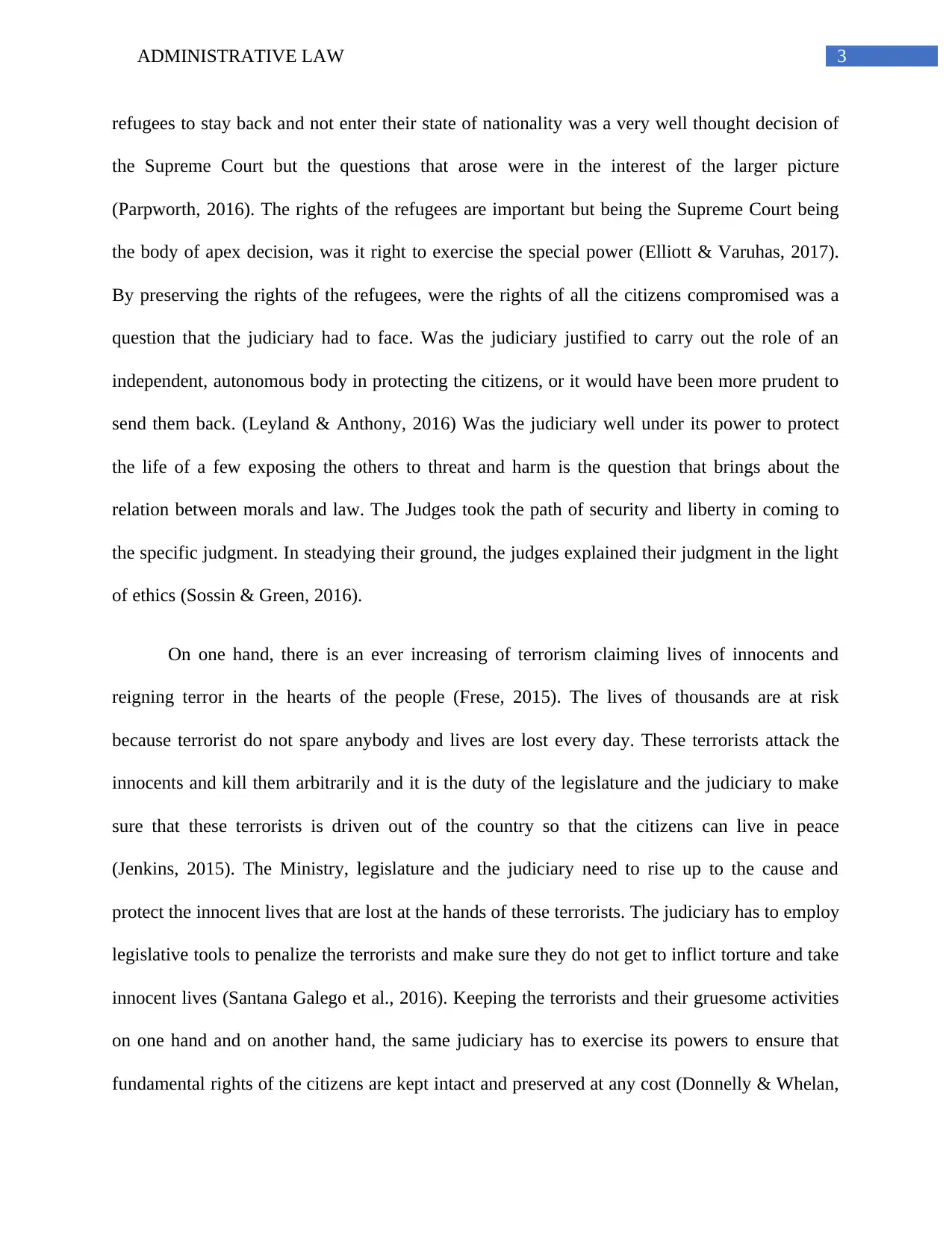
3ADMINISTRATIVE LAW
refugees to stay back and not enter their state of nationality was a very well thought decision of
the Supreme Court but the questions that arose were in the interest of the larger picture
(Parpworth, 2016). The rights of the refugees are important but being the Supreme Court being
the body of apex decision, was it right to exercise the special power (Elliott & Varuhas, 2017).
By preserving the rights of the refugees, were the rights of all the citizens compromised was a
question that the judiciary had to face. Was the judiciary justified to carry out the role of an
independent, autonomous body in protecting the citizens, or it would have been more prudent to
send them back. (Leyland & Anthony, 2016) Was the judiciary well under its power to protect
the life of a few exposing the others to threat and harm is the question that brings about the
relation between morals and law. The Judges took the path of security and liberty in coming to
the specific judgment. In steadying their ground, the judges explained their judgment in the light
of ethics (Sossin & Green, 2016).
On one hand, there is an ever increasing of terrorism claiming lives of innocents and
reigning terror in the hearts of the people (Frese, 2015). The lives of thousands are at risk
because terrorist do not spare anybody and lives are lost every day. These terrorists attack the
innocents and kill them arbitrarily and it is the duty of the legislature and the judiciary to make
sure that these terrorists is driven out of the country so that the citizens can live in peace
(Jenkins, 2015). The Ministry, legislature and the judiciary need to rise up to the cause and
protect the innocent lives that are lost at the hands of these terrorists. The judiciary has to employ
legislative tools to penalize the terrorists and make sure they do not get to inflict torture and take
innocent lives (Santana Galego et al., 2016). Keeping the terrorists and their gruesome activities
on one hand and on another hand, the same judiciary has to exercise its powers to ensure that
fundamental rights of the citizens are kept intact and preserved at any cost (Donnelly & Whelan,
refugees to stay back and not enter their state of nationality was a very well thought decision of
the Supreme Court but the questions that arose were in the interest of the larger picture
(Parpworth, 2016). The rights of the refugees are important but being the Supreme Court being
the body of apex decision, was it right to exercise the special power (Elliott & Varuhas, 2017).
By preserving the rights of the refugees, were the rights of all the citizens compromised was a
question that the judiciary had to face. Was the judiciary justified to carry out the role of an
independent, autonomous body in protecting the citizens, or it would have been more prudent to
send them back. (Leyland & Anthony, 2016) Was the judiciary well under its power to protect
the life of a few exposing the others to threat and harm is the question that brings about the
relation between morals and law. The Judges took the path of security and liberty in coming to
the specific judgment. In steadying their ground, the judges explained their judgment in the light
of ethics (Sossin & Green, 2016).
On one hand, there is an ever increasing of terrorism claiming lives of innocents and
reigning terror in the hearts of the people (Frese, 2015). The lives of thousands are at risk
because terrorist do not spare anybody and lives are lost every day. These terrorists attack the
innocents and kill them arbitrarily and it is the duty of the legislature and the judiciary to make
sure that these terrorists is driven out of the country so that the citizens can live in peace
(Jenkins, 2015). The Ministry, legislature and the judiciary need to rise up to the cause and
protect the innocent lives that are lost at the hands of these terrorists. The judiciary has to employ
legislative tools to penalize the terrorists and make sure they do not get to inflict torture and take
innocent lives (Santana Galego et al., 2016). Keeping the terrorists and their gruesome activities
on one hand and on another hand, the same judiciary has to exercise its powers to ensure that
fundamental rights of the citizens are kept intact and preserved at any cost (Donnelly & Whelan,
Secure Best Marks with AI Grader
Need help grading? Try our AI Grader for instant feedback on your assignments.
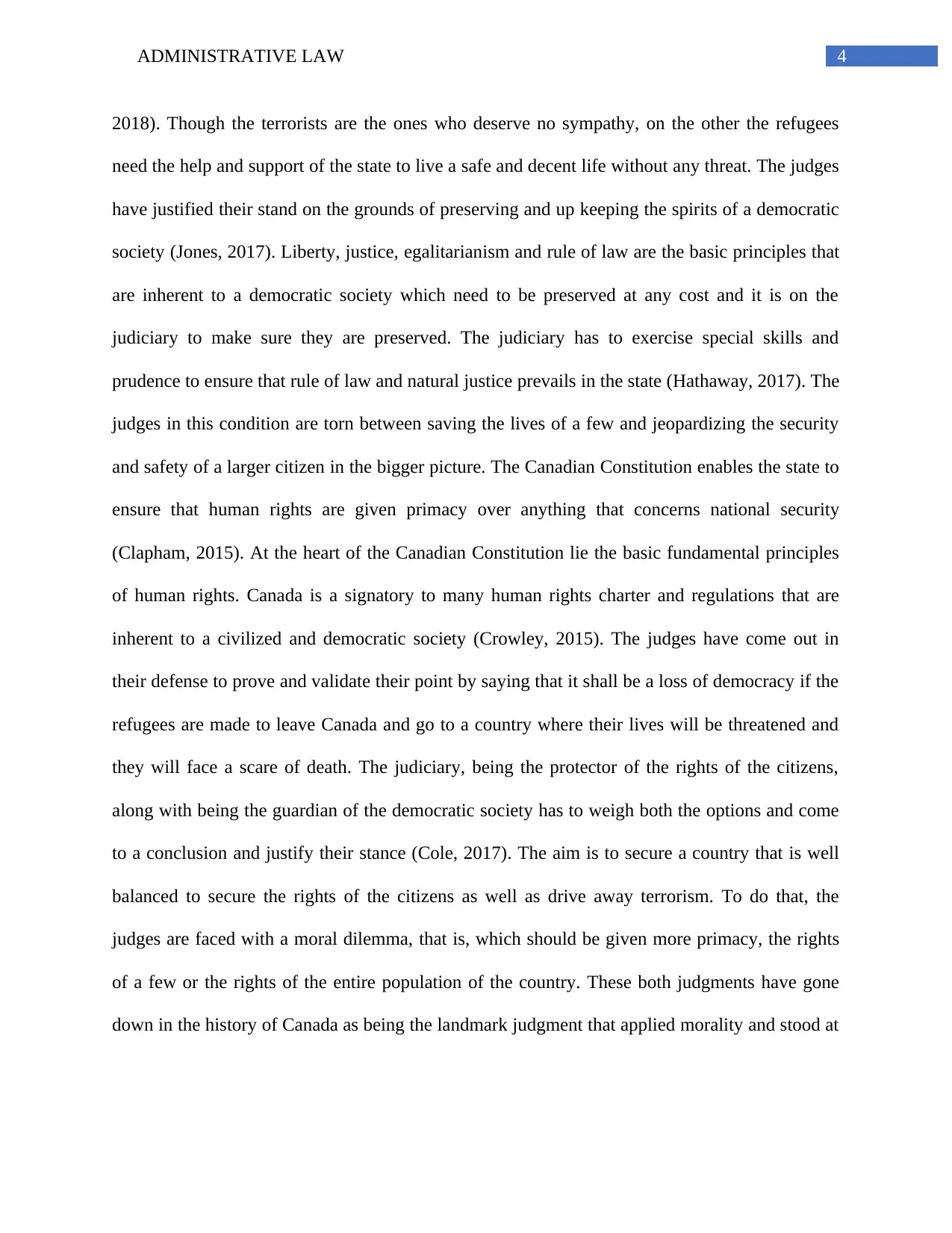
4ADMINISTRATIVE LAW
2018). Though the terrorists are the ones who deserve no sympathy, on the other the refugees
need the help and support of the state to live a safe and decent life without any threat. The judges
have justified their stand on the grounds of preserving and up keeping the spirits of a democratic
society (Jones, 2017). Liberty, justice, egalitarianism and rule of law are the basic principles that
are inherent to a democratic society which need to be preserved at any cost and it is on the
judiciary to make sure they are preserved. The judiciary has to exercise special skills and
prudence to ensure that rule of law and natural justice prevails in the state (Hathaway, 2017). The
judges in this condition are torn between saving the lives of a few and jeopardizing the security
and safety of a larger citizen in the bigger picture. The Canadian Constitution enables the state to
ensure that human rights are given primacy over anything that concerns national security
(Clapham, 2015). At the heart of the Canadian Constitution lie the basic fundamental principles
of human rights. Canada is a signatory to many human rights charter and regulations that are
inherent to a civilized and democratic society (Crowley, 2015). The judges have come out in
their defense to prove and validate their point by saying that it shall be a loss of democracy if the
refugees are made to leave Canada and go to a country where their lives will be threatened and
they will face a scare of death. The judiciary, being the protector of the rights of the citizens,
along with being the guardian of the democratic society has to weigh both the options and come
to a conclusion and justify their stance (Cole, 2017). The aim is to secure a country that is well
balanced to secure the rights of the citizens as well as drive away terrorism. To do that, the
judges are faced with a moral dilemma, that is, which should be given more primacy, the rights
of a few or the rights of the entire population of the country. These both judgments have gone
down in the history of Canada as being the landmark judgment that applied morality and stood at
2018). Though the terrorists are the ones who deserve no sympathy, on the other the refugees
need the help and support of the state to live a safe and decent life without any threat. The judges
have justified their stand on the grounds of preserving and up keeping the spirits of a democratic
society (Jones, 2017). Liberty, justice, egalitarianism and rule of law are the basic principles that
are inherent to a democratic society which need to be preserved at any cost and it is on the
judiciary to make sure they are preserved. The judiciary has to exercise special skills and
prudence to ensure that rule of law and natural justice prevails in the state (Hathaway, 2017). The
judges in this condition are torn between saving the lives of a few and jeopardizing the security
and safety of a larger citizen in the bigger picture. The Canadian Constitution enables the state to
ensure that human rights are given primacy over anything that concerns national security
(Clapham, 2015). At the heart of the Canadian Constitution lie the basic fundamental principles
of human rights. Canada is a signatory to many human rights charter and regulations that are
inherent to a civilized and democratic society (Crowley, 2015). The judges have come out in
their defense to prove and validate their point by saying that it shall be a loss of democracy if the
refugees are made to leave Canada and go to a country where their lives will be threatened and
they will face a scare of death. The judiciary, being the protector of the rights of the citizens,
along with being the guardian of the democratic society has to weigh both the options and come
to a conclusion and justify their stance (Cole, 2017). The aim is to secure a country that is well
balanced to secure the rights of the citizens as well as drive away terrorism. To do that, the
judges are faced with a moral dilemma, that is, which should be given more primacy, the rights
of a few or the rights of the entire population of the country. These both judgments have gone
down in the history of Canada as being the landmark judgment that applied morality and stood at
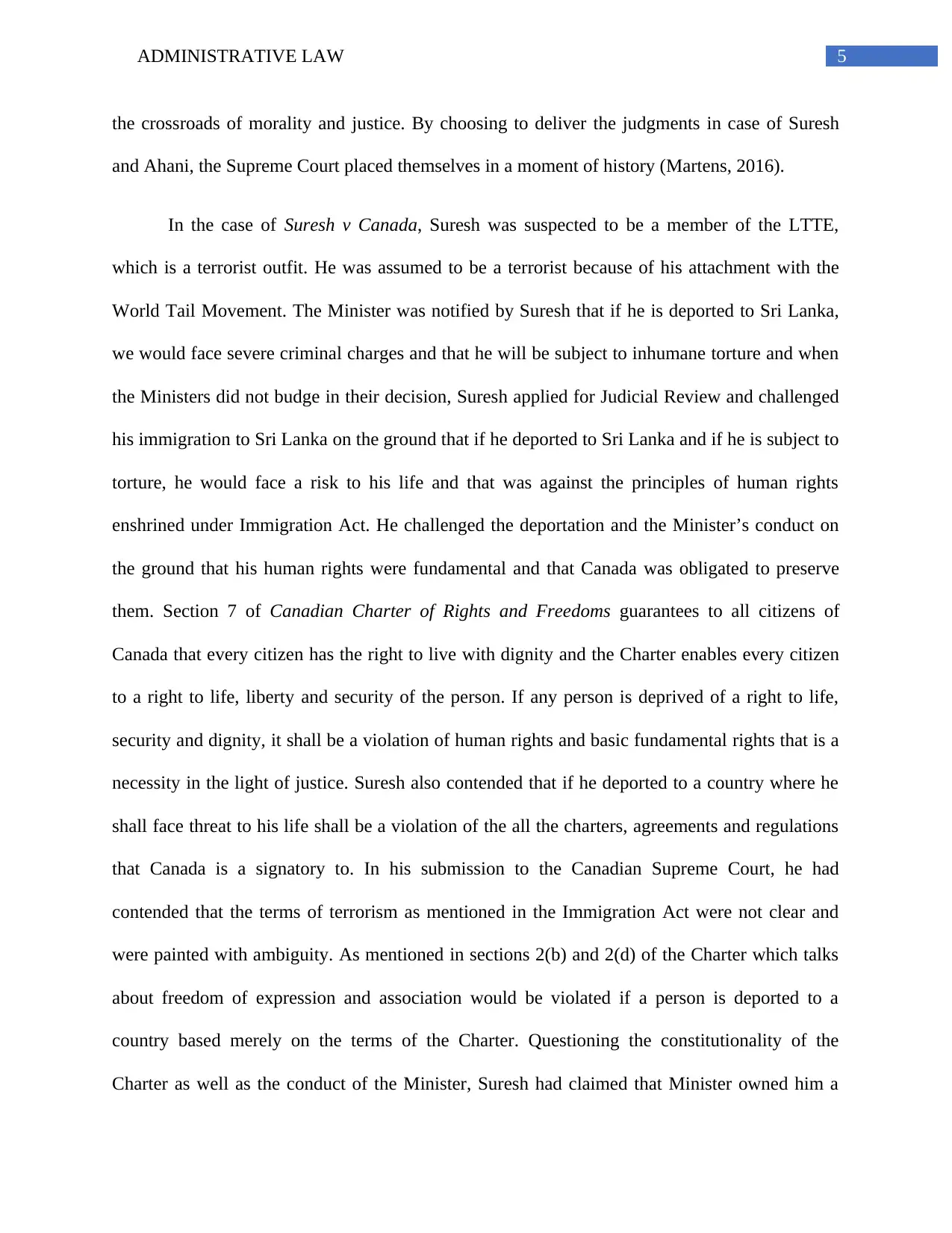
5ADMINISTRATIVE LAW
the crossroads of morality and justice. By choosing to deliver the judgments in case of Suresh
and Ahani, the Supreme Court placed themselves in a moment of history (Martens, 2016).
In the case of Suresh v Canada, Suresh was suspected to be a member of the LTTE,
which is a terrorist outfit. He was assumed to be a terrorist because of his attachment with the
World Tail Movement. The Minister was notified by Suresh that if he is deported to Sri Lanka,
we would face severe criminal charges and that he will be subject to inhumane torture and when
the Ministers did not budge in their decision, Suresh applied for Judicial Review and challenged
his immigration to Sri Lanka on the ground that if he deported to Sri Lanka and if he is subject to
torture, he would face a risk to his life and that was against the principles of human rights
enshrined under Immigration Act. He challenged the deportation and the Minister’s conduct on
the ground that his human rights were fundamental and that Canada was obligated to preserve
them. Section 7 of Canadian Charter of Rights and Freedoms guarantees to all citizens of
Canada that every citizen has the right to live with dignity and the Charter enables every citizen
to a right to life, liberty and security of the person. If any person is deprived of a right to life,
security and dignity, it shall be a violation of human rights and basic fundamental rights that is a
necessity in the light of justice. Suresh also contended that if he deported to a country where he
shall face threat to his life shall be a violation of the all the charters, agreements and regulations
that Canada is a signatory to. In his submission to the Canadian Supreme Court, he had
contended that the terms of terrorism as mentioned in the Immigration Act were not clear and
were painted with ambiguity. As mentioned in sections 2(b) and 2(d) of the Charter which talks
about freedom of expression and association would be violated if a person is deported to a
country based merely on the terms of the Charter. Questioning the constitutionality of the
Charter as well as the conduct of the Minister, Suresh had claimed that Minister owned him a
the crossroads of morality and justice. By choosing to deliver the judgments in case of Suresh
and Ahani, the Supreme Court placed themselves in a moment of history (Martens, 2016).
In the case of Suresh v Canada, Suresh was suspected to be a member of the LTTE,
which is a terrorist outfit. He was assumed to be a terrorist because of his attachment with the
World Tail Movement. The Minister was notified by Suresh that if he is deported to Sri Lanka,
we would face severe criminal charges and that he will be subject to inhumane torture and when
the Ministers did not budge in their decision, Suresh applied for Judicial Review and challenged
his immigration to Sri Lanka on the ground that if he deported to Sri Lanka and if he is subject to
torture, he would face a risk to his life and that was against the principles of human rights
enshrined under Immigration Act. He challenged the deportation and the Minister’s conduct on
the ground that his human rights were fundamental and that Canada was obligated to preserve
them. Section 7 of Canadian Charter of Rights and Freedoms guarantees to all citizens of
Canada that every citizen has the right to live with dignity and the Charter enables every citizen
to a right to life, liberty and security of the person. If any person is deprived of a right to life,
security and dignity, it shall be a violation of human rights and basic fundamental rights that is a
necessity in the light of justice. Suresh also contended that if he deported to a country where he
shall face threat to his life shall be a violation of the all the charters, agreements and regulations
that Canada is a signatory to. In his submission to the Canadian Supreme Court, he had
contended that the terms of terrorism as mentioned in the Immigration Act were not clear and
were painted with ambiguity. As mentioned in sections 2(b) and 2(d) of the Charter which talks
about freedom of expression and association would be violated if a person is deported to a
country based merely on the terms of the Charter. Questioning the constitutionality of the
Charter as well as the conduct of the Minister, Suresh had claimed that Minister owned him a
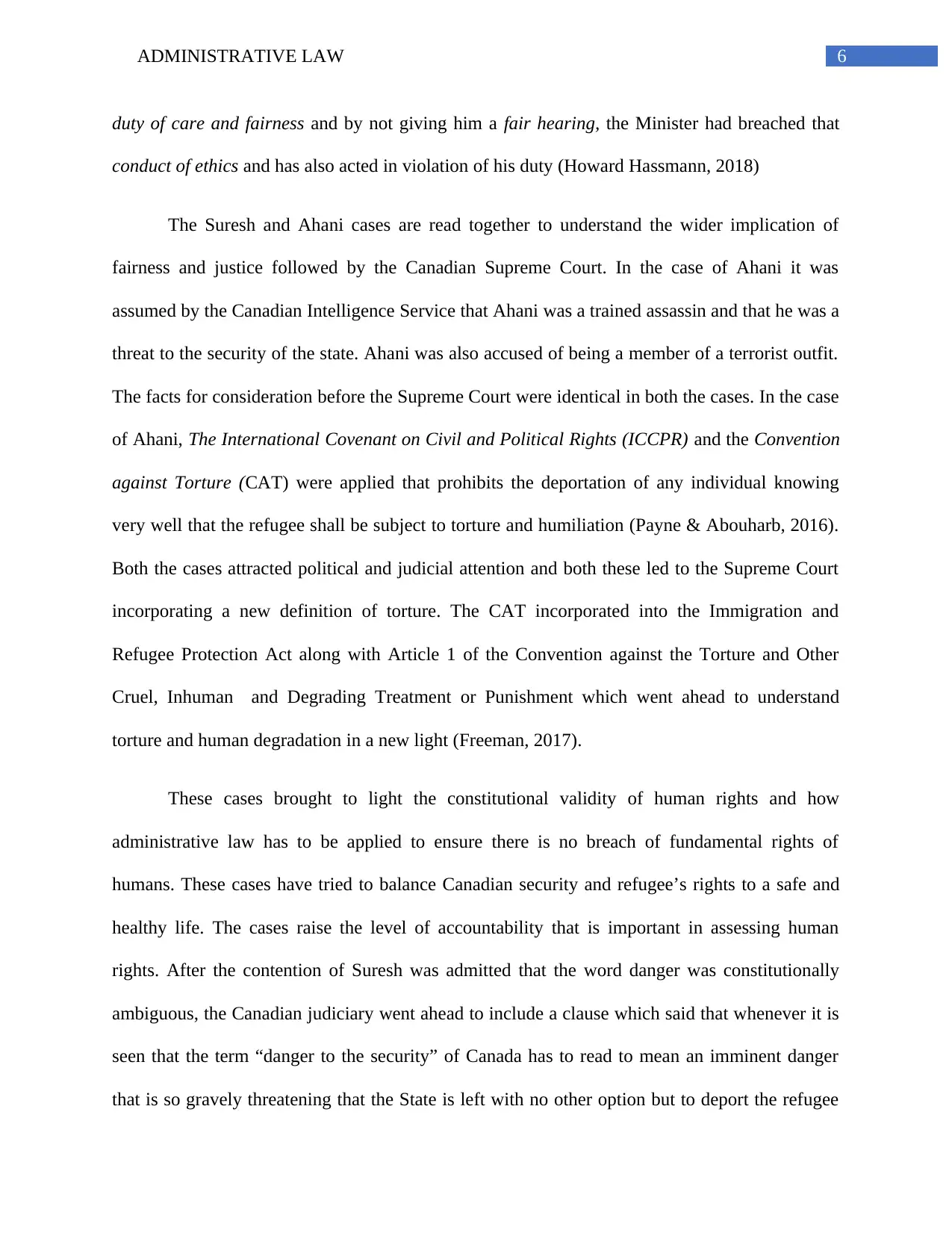
6ADMINISTRATIVE LAW
duty of care and fairness and by not giving him a fair hearing, the Minister had breached that
conduct of ethics and has also acted in violation of his duty (Howard Hassmann, 2018)
The Suresh and Ahani cases are read together to understand the wider implication of
fairness and justice followed by the Canadian Supreme Court. In the case of Ahani it was
assumed by the Canadian Intelligence Service that Ahani was a trained assassin and that he was a
threat to the security of the state. Ahani was also accused of being a member of a terrorist outfit.
The facts for consideration before the Supreme Court were identical in both the cases. In the case
of Ahani, The International Covenant on Civil and Political Rights (ICCPR) and the Convention
against Torture (CAT) were applied that prohibits the deportation of any individual knowing
very well that the refugee shall be subject to torture and humiliation (Payne & Abouharb, 2016).
Both the cases attracted political and judicial attention and both these led to the Supreme Court
incorporating a new definition of torture. The CAT incorporated into the Immigration and
Refugee Protection Act along with Article 1 of the Convention against the Torture and Other
Cruel, Inhuman and Degrading Treatment or Punishment which went ahead to understand
torture and human degradation in a new light (Freeman, 2017).
These cases brought to light the constitutional validity of human rights and how
administrative law has to be applied to ensure there is no breach of fundamental rights of
humans. These cases have tried to balance Canadian security and refugee’s rights to a safe and
healthy life. The cases raise the level of accountability that is important in assessing human
rights. After the contention of Suresh was admitted that the word danger was constitutionally
ambiguous, the Canadian judiciary went ahead to include a clause which said that whenever it is
seen that the term “danger to the security” of Canada has to read to mean an imminent danger
that is so gravely threatening that the State is left with no other option but to deport the refugee
duty of care and fairness and by not giving him a fair hearing, the Minister had breached that
conduct of ethics and has also acted in violation of his duty (Howard Hassmann, 2018)
The Suresh and Ahani cases are read together to understand the wider implication of
fairness and justice followed by the Canadian Supreme Court. In the case of Ahani it was
assumed by the Canadian Intelligence Service that Ahani was a trained assassin and that he was a
threat to the security of the state. Ahani was also accused of being a member of a terrorist outfit.
The facts for consideration before the Supreme Court were identical in both the cases. In the case
of Ahani, The International Covenant on Civil and Political Rights (ICCPR) and the Convention
against Torture (CAT) were applied that prohibits the deportation of any individual knowing
very well that the refugee shall be subject to torture and humiliation (Payne & Abouharb, 2016).
Both the cases attracted political and judicial attention and both these led to the Supreme Court
incorporating a new definition of torture. The CAT incorporated into the Immigration and
Refugee Protection Act along with Article 1 of the Convention against the Torture and Other
Cruel, Inhuman and Degrading Treatment or Punishment which went ahead to understand
torture and human degradation in a new light (Freeman, 2017).
These cases brought to light the constitutional validity of human rights and how
administrative law has to be applied to ensure there is no breach of fundamental rights of
humans. These cases have tried to balance Canadian security and refugee’s rights to a safe and
healthy life. The cases raise the level of accountability that is important in assessing human
rights. After the contention of Suresh was admitted that the word danger was constitutionally
ambiguous, the Canadian judiciary went ahead to include a clause which said that whenever it is
seen that the term “danger to the security” of Canada has to read to mean an imminent danger
that is so gravely threatening that the State is left with no other option but to deport the refugee
Paraphrase This Document
Need a fresh take? Get an instant paraphrase of this document with our AI Paraphraser
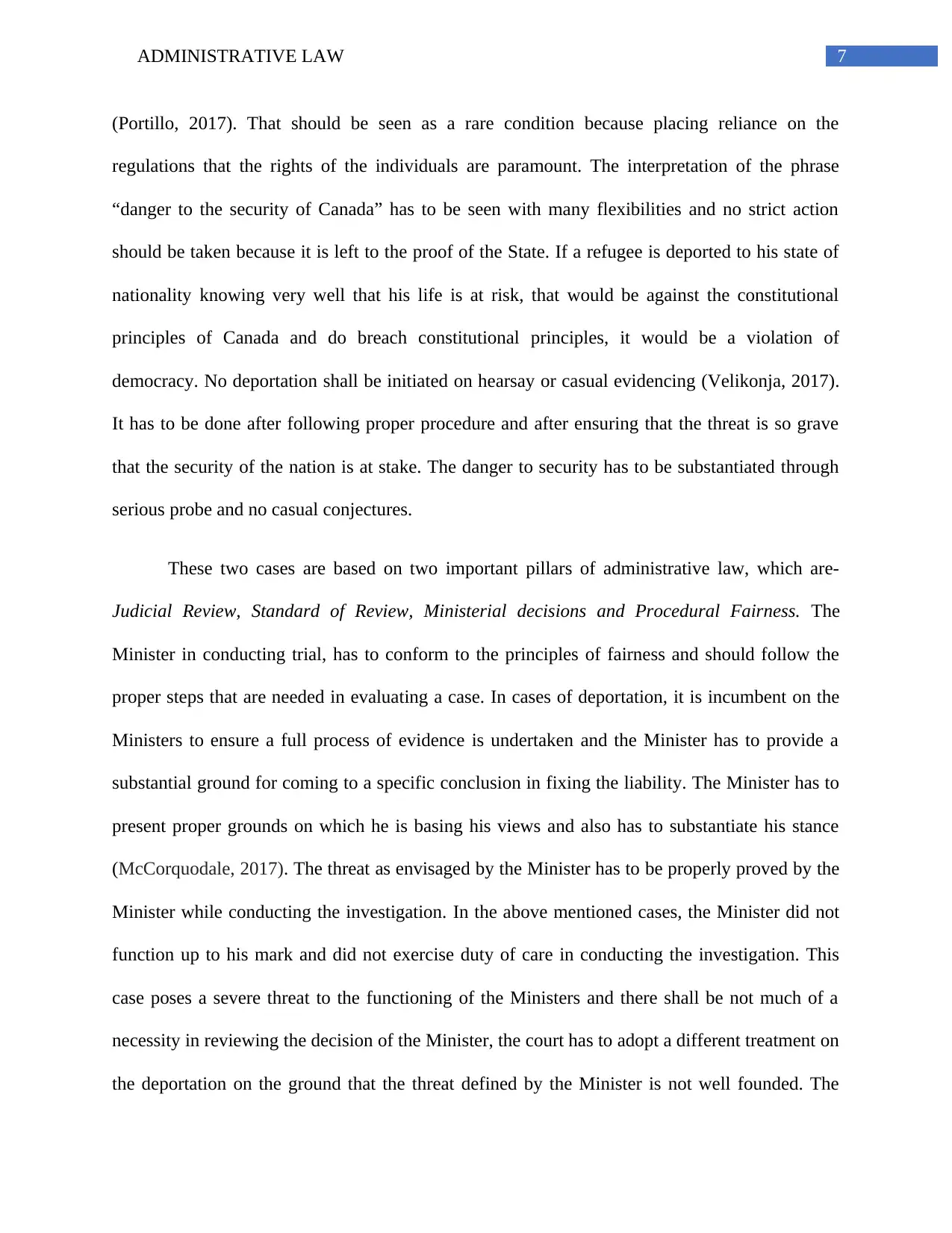
7ADMINISTRATIVE LAW
(Portillo, 2017). That should be seen as a rare condition because placing reliance on the
regulations that the rights of the individuals are paramount. The interpretation of the phrase
“danger to the security of Canada” has to be seen with many flexibilities and no strict action
should be taken because it is left to the proof of the State. If a refugee is deported to his state of
nationality knowing very well that his life is at risk, that would be against the constitutional
principles of Canada and do breach constitutional principles, it would be a violation of
democracy. No deportation shall be initiated on hearsay or casual evidencing (Velikonja, 2017).
It has to be done after following proper procedure and after ensuring that the threat is so grave
that the security of the nation is at stake. The danger to security has to be substantiated through
serious probe and no casual conjectures.
These two cases are based on two important pillars of administrative law, which are-
Judicial Review, Standard of Review, Ministerial decisions and Procedural Fairness. The
Minister in conducting trial, has to conform to the principles of fairness and should follow the
proper steps that are needed in evaluating a case. In cases of deportation, it is incumbent on the
Ministers to ensure a full process of evidence is undertaken and the Minister has to provide a
substantial ground for coming to a specific conclusion in fixing the liability. The Minister has to
present proper grounds on which he is basing his views and also has to substantiate his stance
(McCorquodale, 2017). The threat as envisaged by the Minister has to be properly proved by the
Minister while conducting the investigation. In the above mentioned cases, the Minister did not
function up to his mark and did not exercise duty of care in conducting the investigation. This
case poses a severe threat to the functioning of the Ministers and there shall be not much of a
necessity in reviewing the decision of the Minister, the court has to adopt a different treatment on
the deportation on the ground that the threat defined by the Minister is not well founded. The
(Portillo, 2017). That should be seen as a rare condition because placing reliance on the
regulations that the rights of the individuals are paramount. The interpretation of the phrase
“danger to the security of Canada” has to be seen with many flexibilities and no strict action
should be taken because it is left to the proof of the State. If a refugee is deported to his state of
nationality knowing very well that his life is at risk, that would be against the constitutional
principles of Canada and do breach constitutional principles, it would be a violation of
democracy. No deportation shall be initiated on hearsay or casual evidencing (Velikonja, 2017).
It has to be done after following proper procedure and after ensuring that the threat is so grave
that the security of the nation is at stake. The danger to security has to be substantiated through
serious probe and no casual conjectures.
These two cases are based on two important pillars of administrative law, which are-
Judicial Review, Standard of Review, Ministerial decisions and Procedural Fairness. The
Minister in conducting trial, has to conform to the principles of fairness and should follow the
proper steps that are needed in evaluating a case. In cases of deportation, it is incumbent on the
Ministers to ensure a full process of evidence is undertaken and the Minister has to provide a
substantial ground for coming to a specific conclusion in fixing the liability. The Minister has to
present proper grounds on which he is basing his views and also has to substantiate his stance
(McCorquodale, 2017). The threat as envisaged by the Minister has to be properly proved by the
Minister while conducting the investigation. In the above mentioned cases, the Minister did not
function up to his mark and did not exercise duty of care in conducting the investigation. This
case poses a severe threat to the functioning of the Ministers and there shall be not much of a
necessity in reviewing the decision of the Minister, the court has to adopt a different treatment on
the deportation on the ground that the threat defined by the Minister is not well founded. The
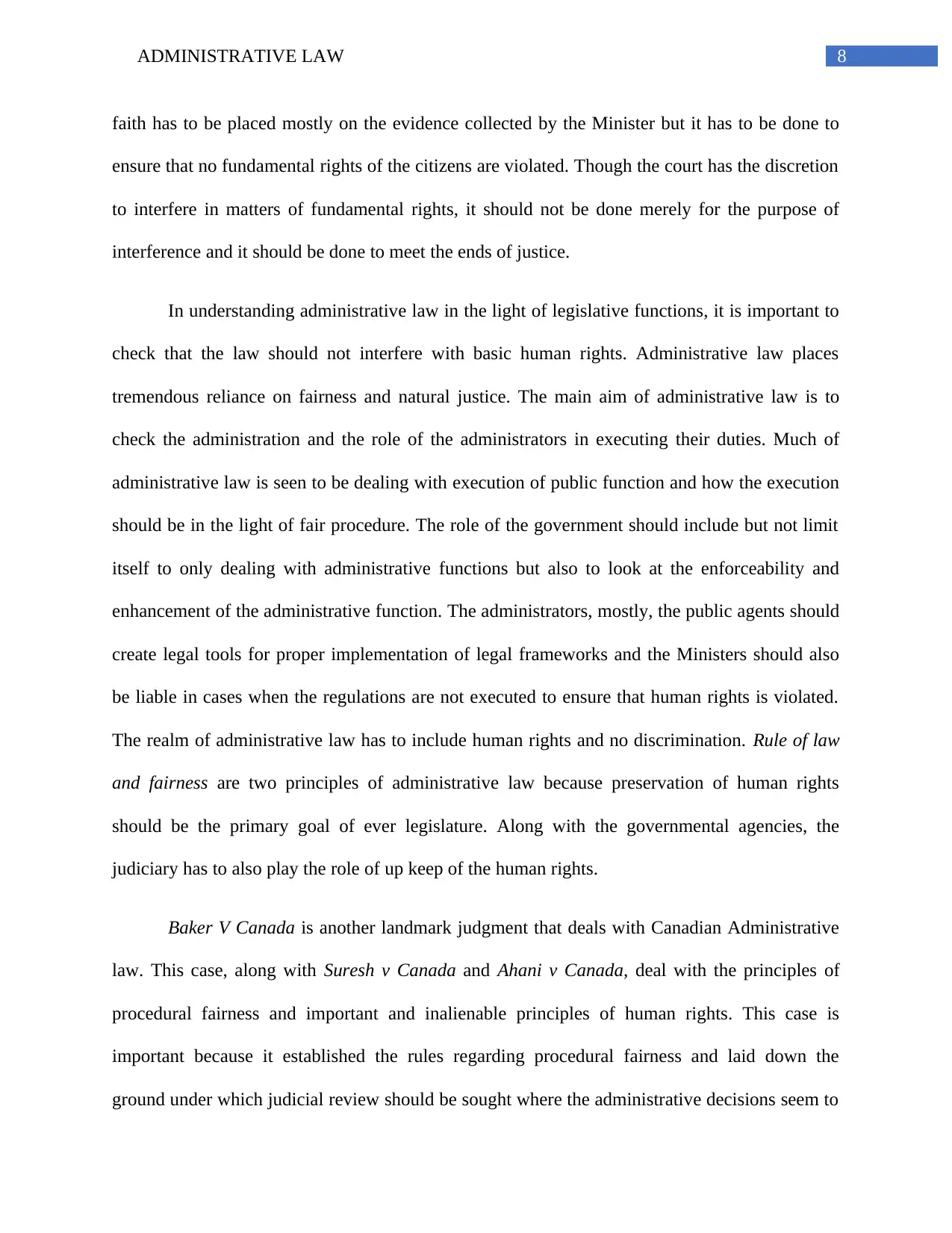
8ADMINISTRATIVE LAW
faith has to be placed mostly on the evidence collected by the Minister but it has to be done to
ensure that no fundamental rights of the citizens are violated. Though the court has the discretion
to interfere in matters of fundamental rights, it should not be done merely for the purpose of
interference and it should be done to meet the ends of justice.
In understanding administrative law in the light of legislative functions, it is important to
check that the law should not interfere with basic human rights. Administrative law places
tremendous reliance on fairness and natural justice. The main aim of administrative law is to
check the administration and the role of the administrators in executing their duties. Much of
administrative law is seen to be dealing with execution of public function and how the execution
should be in the light of fair procedure. The role of the government should include but not limit
itself to only dealing with administrative functions but also to look at the enforceability and
enhancement of the administrative function. The administrators, mostly, the public agents should
create legal tools for proper implementation of legal frameworks and the Ministers should also
be liable in cases when the regulations are not executed to ensure that human rights is violated.
The realm of administrative law has to include human rights and no discrimination. Rule of law
and fairness are two principles of administrative law because preservation of human rights
should be the primary goal of ever legislature. Along with the governmental agencies, the
judiciary has to also play the role of up keep of the human rights.
Baker V Canada is another landmark judgment that deals with Canadian Administrative
law. This case, along with Suresh v Canada and Ahani v Canada, deal with the principles of
procedural fairness and important and inalienable principles of human rights. This case is
important because it established the rules regarding procedural fairness and laid down the
ground under which judicial review should be sought where the administrative decisions seem to
faith has to be placed mostly on the evidence collected by the Minister but it has to be done to
ensure that no fundamental rights of the citizens are violated. Though the court has the discretion
to interfere in matters of fundamental rights, it should not be done merely for the purpose of
interference and it should be done to meet the ends of justice.
In understanding administrative law in the light of legislative functions, it is important to
check that the law should not interfere with basic human rights. Administrative law places
tremendous reliance on fairness and natural justice. The main aim of administrative law is to
check the administration and the role of the administrators in executing their duties. Much of
administrative law is seen to be dealing with execution of public function and how the execution
should be in the light of fair procedure. The role of the government should include but not limit
itself to only dealing with administrative functions but also to look at the enforceability and
enhancement of the administrative function. The administrators, mostly, the public agents should
create legal tools for proper implementation of legal frameworks and the Ministers should also
be liable in cases when the regulations are not executed to ensure that human rights is violated.
The realm of administrative law has to include human rights and no discrimination. Rule of law
and fairness are two principles of administrative law because preservation of human rights
should be the primary goal of ever legislature. Along with the governmental agencies, the
judiciary has to also play the role of up keep of the human rights.
Baker V Canada is another landmark judgment that deals with Canadian Administrative
law. This case, along with Suresh v Canada and Ahani v Canada, deal with the principles of
procedural fairness and important and inalienable principles of human rights. This case is
important because it established the rules regarding procedural fairness and laid down the
ground under which judicial review should be sought where the administrative decisions seem to
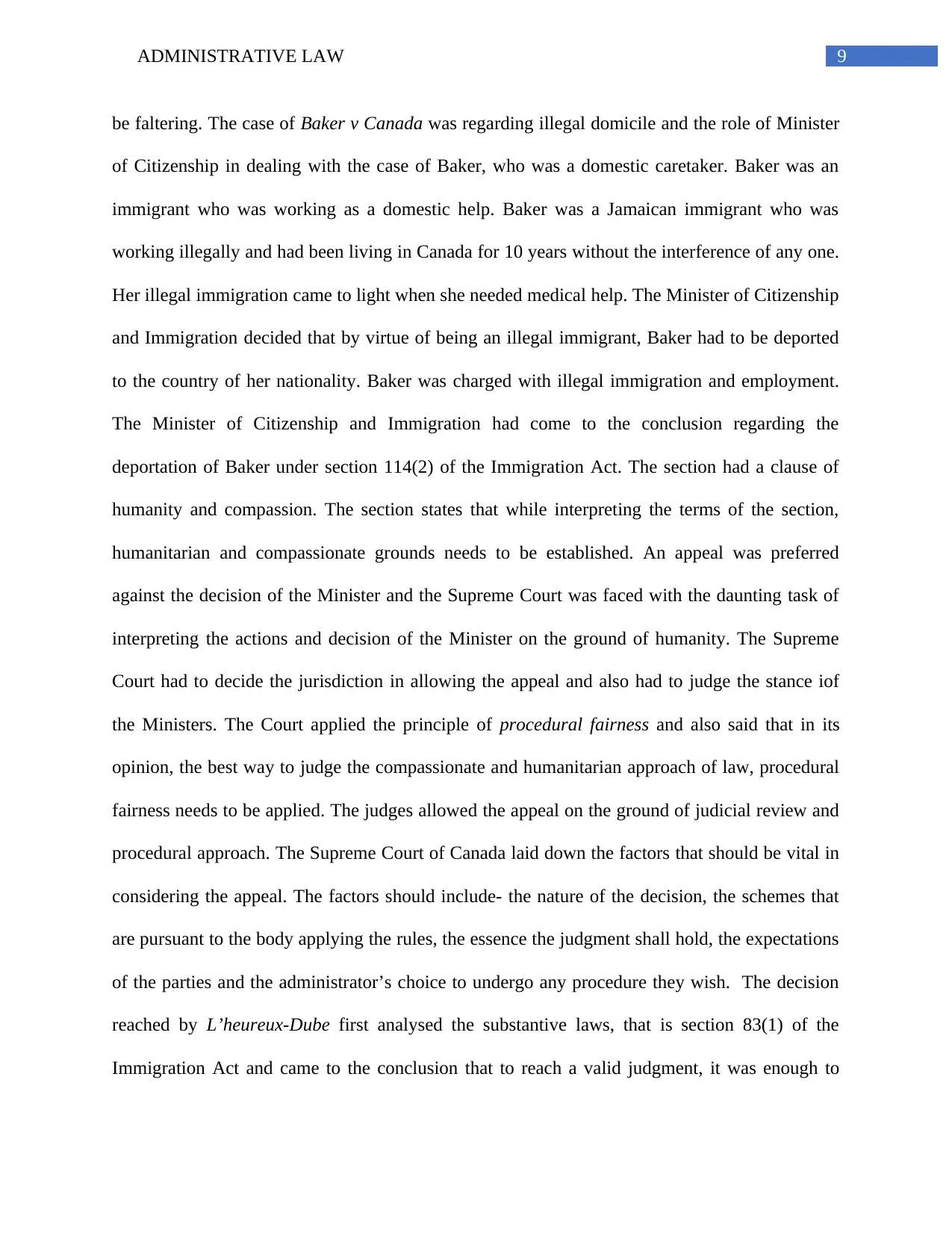
9ADMINISTRATIVE LAW
be faltering. The case of Baker v Canada was regarding illegal domicile and the role of Minister
of Citizenship in dealing with the case of Baker, who was a domestic caretaker. Baker was an
immigrant who was working as a domestic help. Baker was a Jamaican immigrant who was
working illegally and had been living in Canada for 10 years without the interference of any one.
Her illegal immigration came to light when she needed medical help. The Minister of Citizenship
and Immigration decided that by virtue of being an illegal immigrant, Baker had to be deported
to the country of her nationality. Baker was charged with illegal immigration and employment.
The Minister of Citizenship and Immigration had come to the conclusion regarding the
deportation of Baker under section 114(2) of the Immigration Act. The section had a clause of
humanity and compassion. The section states that while interpreting the terms of the section,
humanitarian and compassionate grounds needs to be established. An appeal was preferred
against the decision of the Minister and the Supreme Court was faced with the daunting task of
interpreting the actions and decision of the Minister on the ground of humanity. The Supreme
Court had to decide the jurisdiction in allowing the appeal and also had to judge the stance iof
the Ministers. The Court applied the principle of procedural fairness and also said that in its
opinion, the best way to judge the compassionate and humanitarian approach of law, procedural
fairness needs to be applied. The judges allowed the appeal on the ground of judicial review and
procedural approach. The Supreme Court of Canada laid down the factors that should be vital in
considering the appeal. The factors should include- the nature of the decision, the schemes that
are pursuant to the body applying the rules, the essence the judgment shall hold, the expectations
of the parties and the administrator’s choice to undergo any procedure they wish. The decision
reached by L’heureux-Dube first analysed the substantive laws, that is section 83(1) of the
Immigration Act and came to the conclusion that to reach a valid judgment, it was enough to
be faltering. The case of Baker v Canada was regarding illegal domicile and the role of Minister
of Citizenship in dealing with the case of Baker, who was a domestic caretaker. Baker was an
immigrant who was working as a domestic help. Baker was a Jamaican immigrant who was
working illegally and had been living in Canada for 10 years without the interference of any one.
Her illegal immigration came to light when she needed medical help. The Minister of Citizenship
and Immigration decided that by virtue of being an illegal immigrant, Baker had to be deported
to the country of her nationality. Baker was charged with illegal immigration and employment.
The Minister of Citizenship and Immigration had come to the conclusion regarding the
deportation of Baker under section 114(2) of the Immigration Act. The section had a clause of
humanity and compassion. The section states that while interpreting the terms of the section,
humanitarian and compassionate grounds needs to be established. An appeal was preferred
against the decision of the Minister and the Supreme Court was faced with the daunting task of
interpreting the actions and decision of the Minister on the ground of humanity. The Supreme
Court had to decide the jurisdiction in allowing the appeal and also had to judge the stance iof
the Ministers. The Court applied the principle of procedural fairness and also said that in its
opinion, the best way to judge the compassionate and humanitarian approach of law, procedural
fairness needs to be applied. The judges allowed the appeal on the ground of judicial review and
procedural approach. The Supreme Court of Canada laid down the factors that should be vital in
considering the appeal. The factors should include- the nature of the decision, the schemes that
are pursuant to the body applying the rules, the essence the judgment shall hold, the expectations
of the parties and the administrator’s choice to undergo any procedure they wish. The decision
reached by L’heureux-Dube first analysed the substantive laws, that is section 83(1) of the
Immigration Act and came to the conclusion that to reach a valid judgment, it was enough to
Secure Best Marks with AI Grader
Need help grading? Try our AI Grader for instant feedback on your assignments.
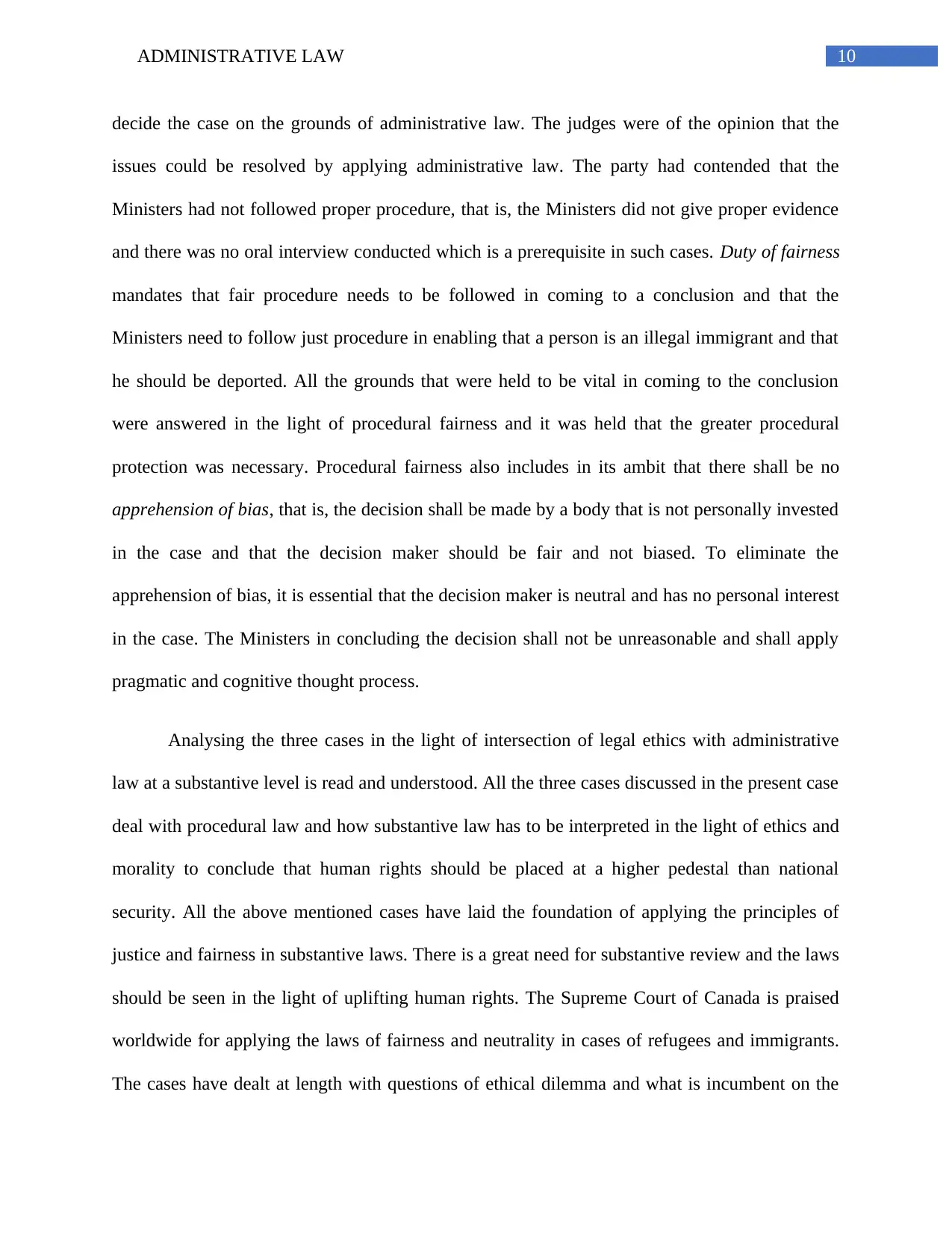
10ADMINISTRATIVE LAW
decide the case on the grounds of administrative law. The judges were of the opinion that the
issues could be resolved by applying administrative law. The party had contended that the
Ministers had not followed proper procedure, that is, the Ministers did not give proper evidence
and there was no oral interview conducted which is a prerequisite in such cases. Duty of fairness
mandates that fair procedure needs to be followed in coming to a conclusion and that the
Ministers need to follow just procedure in enabling that a person is an illegal immigrant and that
he should be deported. All the grounds that were held to be vital in coming to the conclusion
were answered in the light of procedural fairness and it was held that the greater procedural
protection was necessary. Procedural fairness also includes in its ambit that there shall be no
apprehension of bias, that is, the decision shall be made by a body that is not personally invested
in the case and that the decision maker should be fair and not biased. To eliminate the
apprehension of bias, it is essential that the decision maker is neutral and has no personal interest
in the case. The Ministers in concluding the decision shall not be unreasonable and shall apply
pragmatic and cognitive thought process.
Analysing the three cases in the light of intersection of legal ethics with administrative
law at a substantive level is read and understood. All the three cases discussed in the present case
deal with procedural law and how substantive law has to be interpreted in the light of ethics and
morality to conclude that human rights should be placed at a higher pedestal than national
security. All the above mentioned cases have laid the foundation of applying the principles of
justice and fairness in substantive laws. There is a great need for substantive review and the laws
should be seen in the light of uplifting human rights. The Supreme Court of Canada is praised
worldwide for applying the laws of fairness and neutrality in cases of refugees and immigrants.
The cases have dealt at length with questions of ethical dilemma and what is incumbent on the
decide the case on the grounds of administrative law. The judges were of the opinion that the
issues could be resolved by applying administrative law. The party had contended that the
Ministers had not followed proper procedure, that is, the Ministers did not give proper evidence
and there was no oral interview conducted which is a prerequisite in such cases. Duty of fairness
mandates that fair procedure needs to be followed in coming to a conclusion and that the
Ministers need to follow just procedure in enabling that a person is an illegal immigrant and that
he should be deported. All the grounds that were held to be vital in coming to the conclusion
were answered in the light of procedural fairness and it was held that the greater procedural
protection was necessary. Procedural fairness also includes in its ambit that there shall be no
apprehension of bias, that is, the decision shall be made by a body that is not personally invested
in the case and that the decision maker should be fair and not biased. To eliminate the
apprehension of bias, it is essential that the decision maker is neutral and has no personal interest
in the case. The Ministers in concluding the decision shall not be unreasonable and shall apply
pragmatic and cognitive thought process.
Analysing the three cases in the light of intersection of legal ethics with administrative
law at a substantive level is read and understood. All the three cases discussed in the present case
deal with procedural law and how substantive law has to be interpreted in the light of ethics and
morality to conclude that human rights should be placed at a higher pedestal than national
security. All the above mentioned cases have laid the foundation of applying the principles of
justice and fairness in substantive laws. There is a great need for substantive review and the laws
should be seen in the light of uplifting human rights. The Supreme Court of Canada is praised
worldwide for applying the laws of fairness and neutrality in cases of refugees and immigrants.
The cases have dealt at length with questions of ethical dilemma and what is incumbent on the
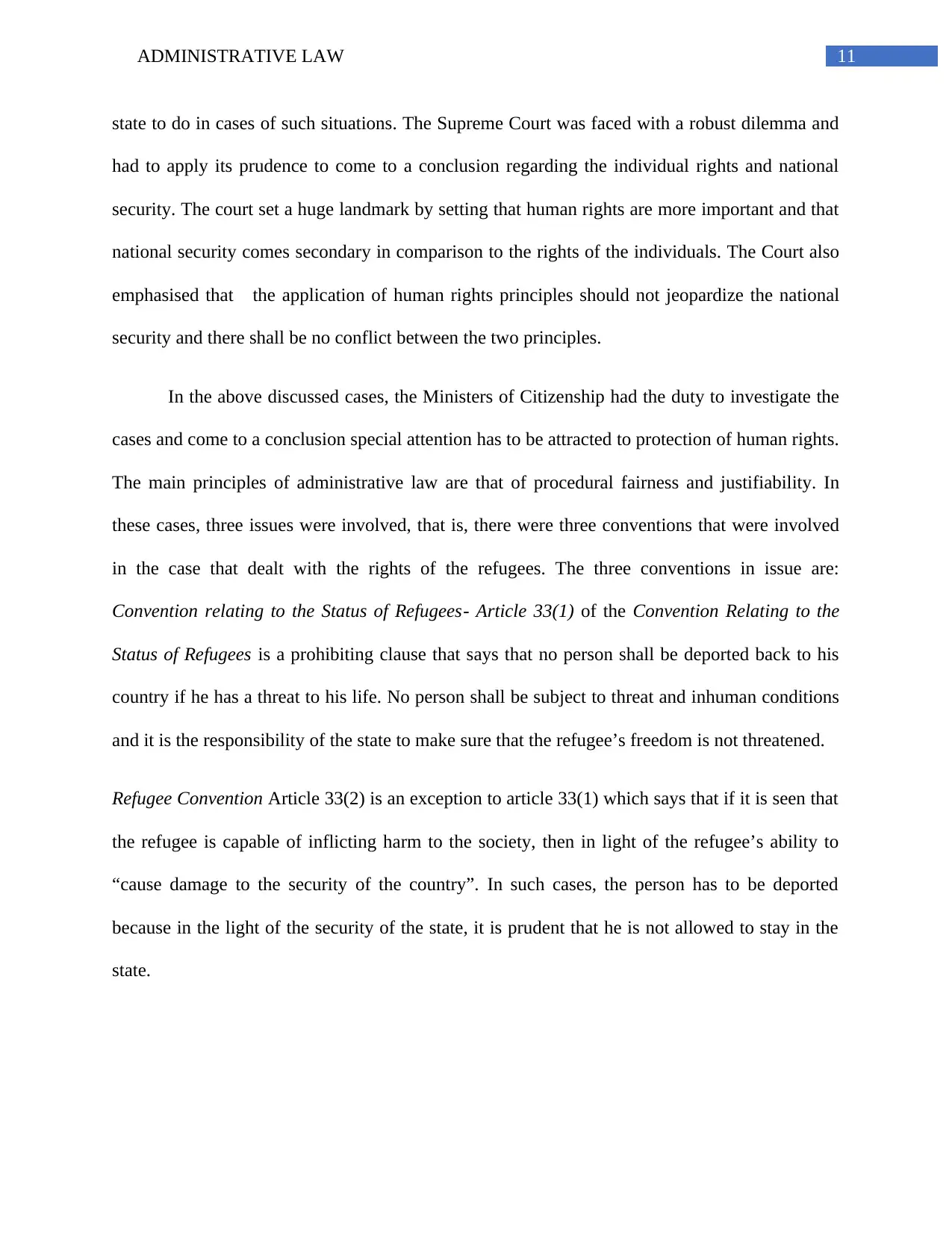
11ADMINISTRATIVE LAW
state to do in cases of such situations. The Supreme Court was faced with a robust dilemma and
had to apply its prudence to come to a conclusion regarding the individual rights and national
security. The court set a huge landmark by setting that human rights are more important and that
national security comes secondary in comparison to the rights of the individuals. The Court also
emphasised that the application of human rights principles should not jeopardize the national
security and there shall be no conflict between the two principles.
In the above discussed cases, the Ministers of Citizenship had the duty to investigate the
cases and come to a conclusion special attention has to be attracted to protection of human rights.
The main principles of administrative law are that of procedural fairness and justifiability. In
these cases, three issues were involved, that is, there were three conventions that were involved
in the case that dealt with the rights of the refugees. The three conventions in issue are:
Convention relating to the Status of Refugees- Article 33(1) of the Convention Relating to the
Status of Refugees is a prohibiting clause that says that no person shall be deported back to his
country if he has a threat to his life. No person shall be subject to threat and inhuman conditions
and it is the responsibility of the state to make sure that the refugee’s freedom is not threatened.
Refugee Convention Article 33(2) is an exception to article 33(1) which says that if it is seen that
the refugee is capable of inflicting harm to the society, then in light of the refugee’s ability to
“cause damage to the security of the country”. In such cases, the person has to be deported
because in the light of the security of the state, it is prudent that he is not allowed to stay in the
state.
state to do in cases of such situations. The Supreme Court was faced with a robust dilemma and
had to apply its prudence to come to a conclusion regarding the individual rights and national
security. The court set a huge landmark by setting that human rights are more important and that
national security comes secondary in comparison to the rights of the individuals. The Court also
emphasised that the application of human rights principles should not jeopardize the national
security and there shall be no conflict between the two principles.
In the above discussed cases, the Ministers of Citizenship had the duty to investigate the
cases and come to a conclusion special attention has to be attracted to protection of human rights.
The main principles of administrative law are that of procedural fairness and justifiability. In
these cases, three issues were involved, that is, there were three conventions that were involved
in the case that dealt with the rights of the refugees. The three conventions in issue are:
Convention relating to the Status of Refugees- Article 33(1) of the Convention Relating to the
Status of Refugees is a prohibiting clause that says that no person shall be deported back to his
country if he has a threat to his life. No person shall be subject to threat and inhuman conditions
and it is the responsibility of the state to make sure that the refugee’s freedom is not threatened.
Refugee Convention Article 33(2) is an exception to article 33(1) which says that if it is seen that
the refugee is capable of inflicting harm to the society, then in light of the refugee’s ability to
“cause damage to the security of the country”. In such cases, the person has to be deported
because in the light of the security of the state, it is prudent that he is not allowed to stay in the
state.
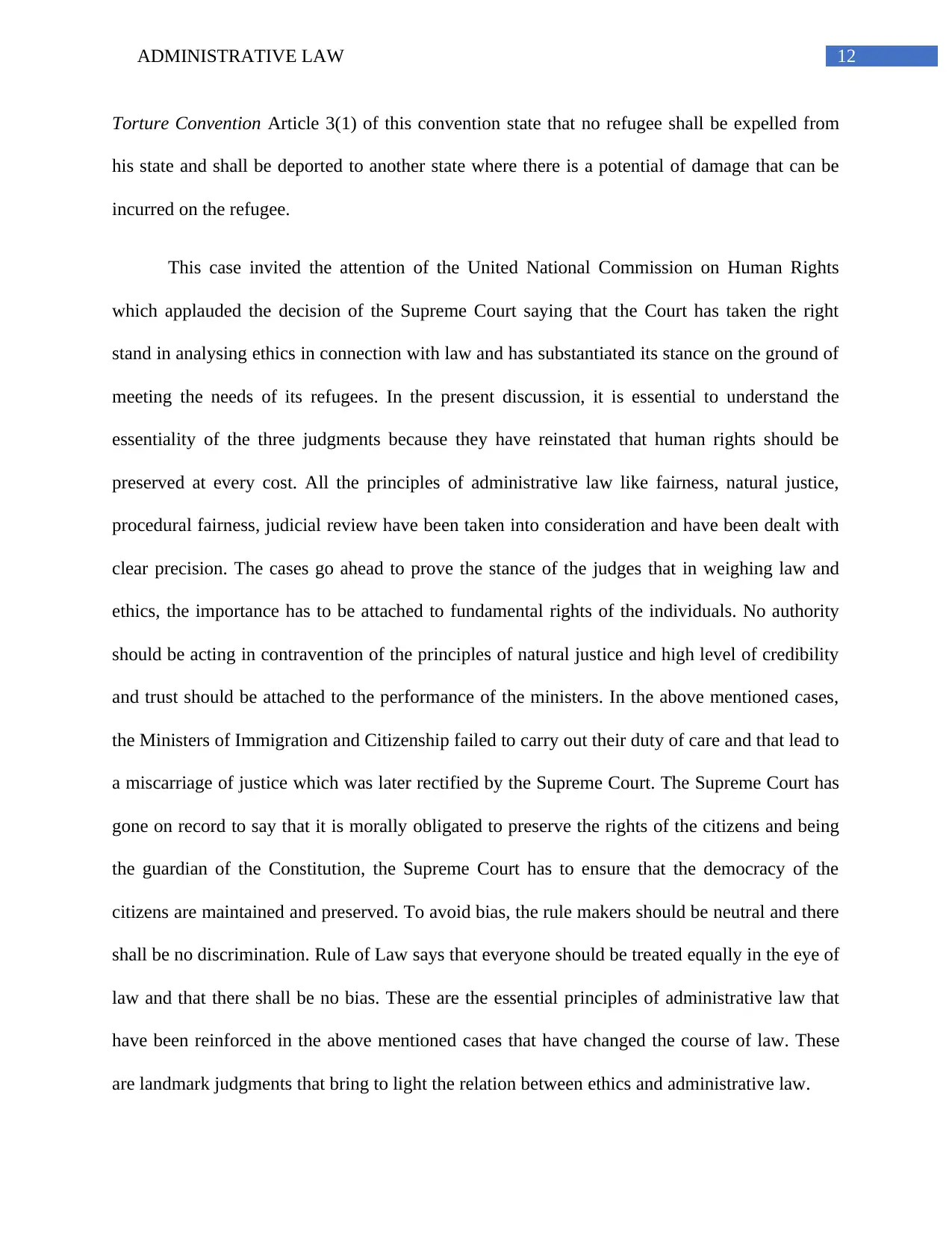
12ADMINISTRATIVE LAW
Torture Convention Article 3(1) of this convention state that no refugee shall be expelled from
his state and shall be deported to another state where there is a potential of damage that can be
incurred on the refugee.
This case invited the attention of the United National Commission on Human Rights
which applauded the decision of the Supreme Court saying that the Court has taken the right
stand in analysing ethics in connection with law and has substantiated its stance on the ground of
meeting the needs of its refugees. In the present discussion, it is essential to understand the
essentiality of the three judgments because they have reinstated that human rights should be
preserved at every cost. All the principles of administrative law like fairness, natural justice,
procedural fairness, judicial review have been taken into consideration and have been dealt with
clear precision. The cases go ahead to prove the stance of the judges that in weighing law and
ethics, the importance has to be attached to fundamental rights of the individuals. No authority
should be acting in contravention of the principles of natural justice and high level of credibility
and trust should be attached to the performance of the ministers. In the above mentioned cases,
the Ministers of Immigration and Citizenship failed to carry out their duty of care and that lead to
a miscarriage of justice which was later rectified by the Supreme Court. The Supreme Court has
gone on record to say that it is morally obligated to preserve the rights of the citizens and being
the guardian of the Constitution, the Supreme Court has to ensure that the democracy of the
citizens are maintained and preserved. To avoid bias, the rule makers should be neutral and there
shall be no discrimination. Rule of Law says that everyone should be treated equally in the eye of
law and that there shall be no bias. These are the essential principles of administrative law that
have been reinforced in the above mentioned cases that have changed the course of law. These
are landmark judgments that bring to light the relation between ethics and administrative law.
Torture Convention Article 3(1) of this convention state that no refugee shall be expelled from
his state and shall be deported to another state where there is a potential of damage that can be
incurred on the refugee.
This case invited the attention of the United National Commission on Human Rights
which applauded the decision of the Supreme Court saying that the Court has taken the right
stand in analysing ethics in connection with law and has substantiated its stance on the ground of
meeting the needs of its refugees. In the present discussion, it is essential to understand the
essentiality of the three judgments because they have reinstated that human rights should be
preserved at every cost. All the principles of administrative law like fairness, natural justice,
procedural fairness, judicial review have been taken into consideration and have been dealt with
clear precision. The cases go ahead to prove the stance of the judges that in weighing law and
ethics, the importance has to be attached to fundamental rights of the individuals. No authority
should be acting in contravention of the principles of natural justice and high level of credibility
and trust should be attached to the performance of the ministers. In the above mentioned cases,
the Ministers of Immigration and Citizenship failed to carry out their duty of care and that lead to
a miscarriage of justice which was later rectified by the Supreme Court. The Supreme Court has
gone on record to say that it is morally obligated to preserve the rights of the citizens and being
the guardian of the Constitution, the Supreme Court has to ensure that the democracy of the
citizens are maintained and preserved. To avoid bias, the rule makers should be neutral and there
shall be no discrimination. Rule of Law says that everyone should be treated equally in the eye of
law and that there shall be no bias. These are the essential principles of administrative law that
have been reinforced in the above mentioned cases that have changed the course of law. These
are landmark judgments that bring to light the relation between ethics and administrative law.
Paraphrase This Document
Need a fresh take? Get an instant paraphrase of this document with our AI Paraphraser
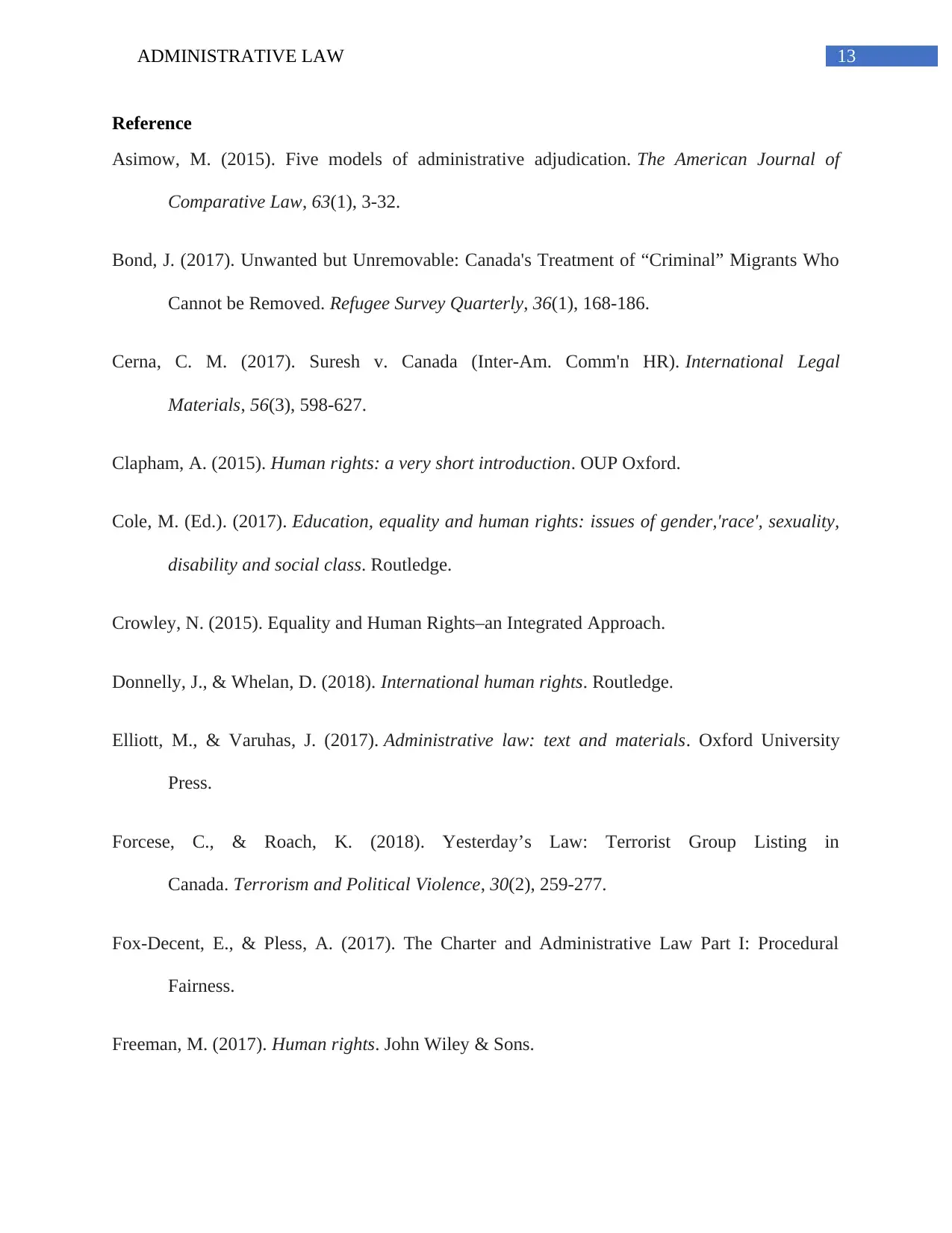
13ADMINISTRATIVE LAW
Reference
Asimow, M. (2015). Five models of administrative adjudication. The American Journal of
Comparative Law, 63(1), 3-32.
Bond, J. (2017). Unwanted but Unremovable: Canada's Treatment of “Criminal” Migrants Who
Cannot be Removed. Refugee Survey Quarterly, 36(1), 168-186.
Cerna, C. M. (2017). Suresh v. Canada (Inter-Am. Comm'n HR). International Legal
Materials, 56(3), 598-627.
Clapham, A. (2015). Human rights: a very short introduction. OUP Oxford.
Cole, M. (Ed.). (2017). Education, equality and human rights: issues of gender,'race', sexuality,
disability and social class. Routledge.
Crowley, N. (2015). Equality and Human Rights–an Integrated Approach.
Donnelly, J., & Whelan, D. (2018). International human rights. Routledge.
Elliott, M., & Varuhas, J. (2017). Administrative law: text and materials. Oxford University
Press.
Forcese, C., & Roach, K. (2018). Yesterday’s Law: Terrorist Group Listing in
Canada. Terrorism and Political Violence, 30(2), 259-277.
Fox-Decent, E., & Pless, A. (2017). The Charter and Administrative Law Part I: Procedural
Fairness.
Freeman, M. (2017). Human rights. John Wiley & Sons.
Reference
Asimow, M. (2015). Five models of administrative adjudication. The American Journal of
Comparative Law, 63(1), 3-32.
Bond, J. (2017). Unwanted but Unremovable: Canada's Treatment of “Criminal” Migrants Who
Cannot be Removed. Refugee Survey Quarterly, 36(1), 168-186.
Cerna, C. M. (2017). Suresh v. Canada (Inter-Am. Comm'n HR). International Legal
Materials, 56(3), 598-627.
Clapham, A. (2015). Human rights: a very short introduction. OUP Oxford.
Cole, M. (Ed.). (2017). Education, equality and human rights: issues of gender,'race', sexuality,
disability and social class. Routledge.
Crowley, N. (2015). Equality and Human Rights–an Integrated Approach.
Donnelly, J., & Whelan, D. (2018). International human rights. Routledge.
Elliott, M., & Varuhas, J. (2017). Administrative law: text and materials. Oxford University
Press.
Forcese, C., & Roach, K. (2018). Yesterday’s Law: Terrorist Group Listing in
Canada. Terrorism and Political Violence, 30(2), 259-277.
Fox-Decent, E., & Pless, A. (2017). The Charter and Administrative Law Part I: Procedural
Fairness.
Freeman, M. (2017). Human rights. John Wiley & Sons.
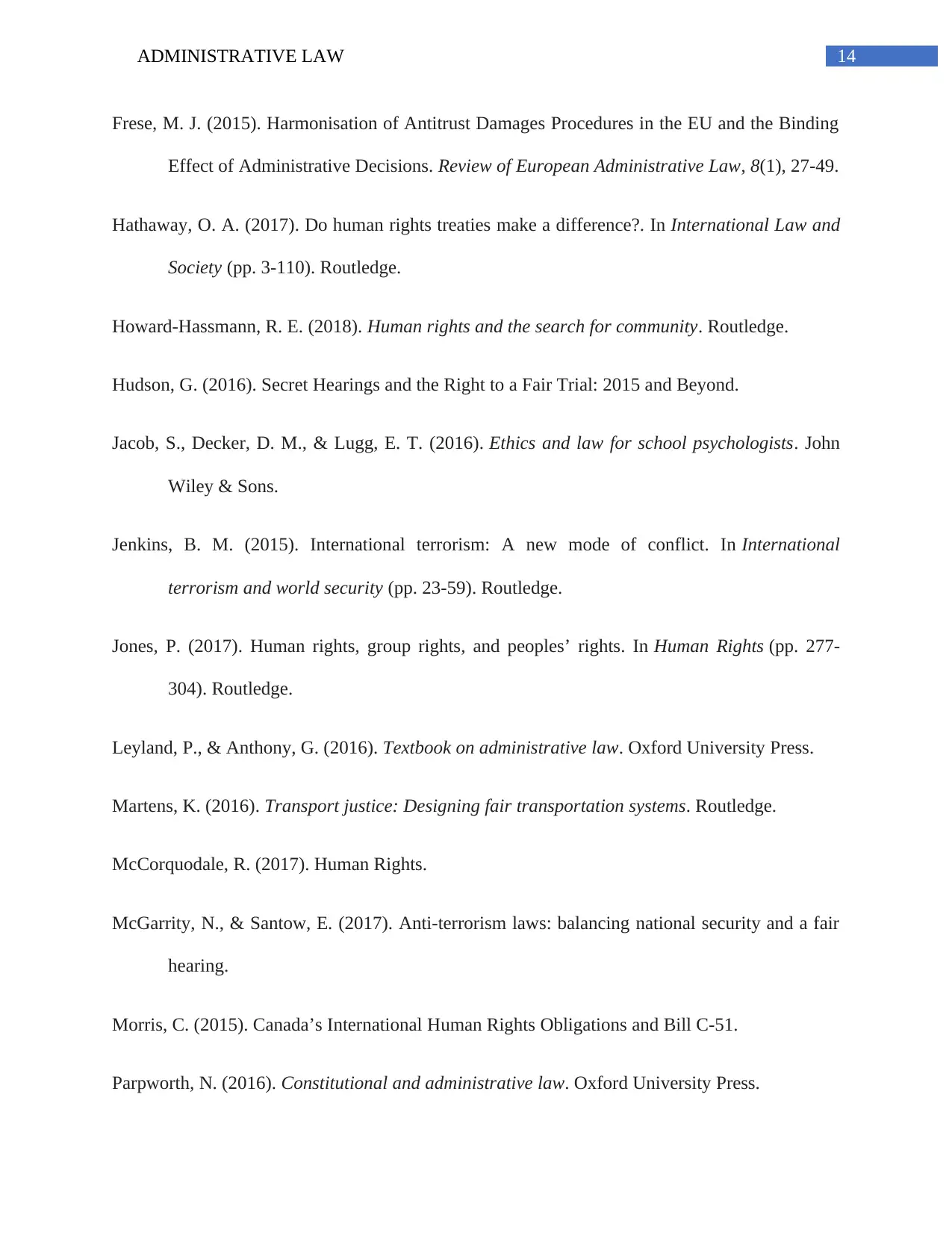
14ADMINISTRATIVE LAW
Frese, M. J. (2015). Harmonisation of Antitrust Damages Procedures in the EU and the Binding
Effect of Administrative Decisions. Review of European Administrative Law, 8(1), 27-49.
Hathaway, O. A. (2017). Do human rights treaties make a difference?. In International Law and
Society (pp. 3-110). Routledge.
Howard-Hassmann, R. E. (2018). Human rights and the search for community. Routledge.
Hudson, G. (2016). Secret Hearings and the Right to a Fair Trial: 2015 and Beyond.
Jacob, S., Decker, D. M., & Lugg, E. T. (2016). Ethics and law for school psychologists. John
Wiley & Sons.
Jenkins, B. M. (2015). International terrorism: A new mode of conflict. In International
terrorism and world security (pp. 23-59). Routledge.
Jones, P. (2017). Human rights, group rights, and peoples’ rights. In Human Rights (pp. 277-
304). Routledge.
Leyland, P., & Anthony, G. (2016). Textbook on administrative law. Oxford University Press.
Martens, K. (2016). Transport justice: Designing fair transportation systems. Routledge.
McCorquodale, R. (2017). Human Rights.
McGarrity, N., & Santow, E. (2017). Anti-terrorism laws: balancing national security and a fair
hearing.
Morris, C. (2015). Canada’s International Human Rights Obligations and Bill C-51.
Parpworth, N. (2016). Constitutional and administrative law. Oxford University Press.
Frese, M. J. (2015). Harmonisation of Antitrust Damages Procedures in the EU and the Binding
Effect of Administrative Decisions. Review of European Administrative Law, 8(1), 27-49.
Hathaway, O. A. (2017). Do human rights treaties make a difference?. In International Law and
Society (pp. 3-110). Routledge.
Howard-Hassmann, R. E. (2018). Human rights and the search for community. Routledge.
Hudson, G. (2016). Secret Hearings and the Right to a Fair Trial: 2015 and Beyond.
Jacob, S., Decker, D. M., & Lugg, E. T. (2016). Ethics and law for school psychologists. John
Wiley & Sons.
Jenkins, B. M. (2015). International terrorism: A new mode of conflict. In International
terrorism and world security (pp. 23-59). Routledge.
Jones, P. (2017). Human rights, group rights, and peoples’ rights. In Human Rights (pp. 277-
304). Routledge.
Leyland, P., & Anthony, G. (2016). Textbook on administrative law. Oxford University Press.
Martens, K. (2016). Transport justice: Designing fair transportation systems. Routledge.
McCorquodale, R. (2017). Human Rights.
McGarrity, N., & Santow, E. (2017). Anti-terrorism laws: balancing national security and a fair
hearing.
Morris, C. (2015). Canada’s International Human Rights Obligations and Bill C-51.
Parpworth, N. (2016). Constitutional and administrative law. Oxford University Press.
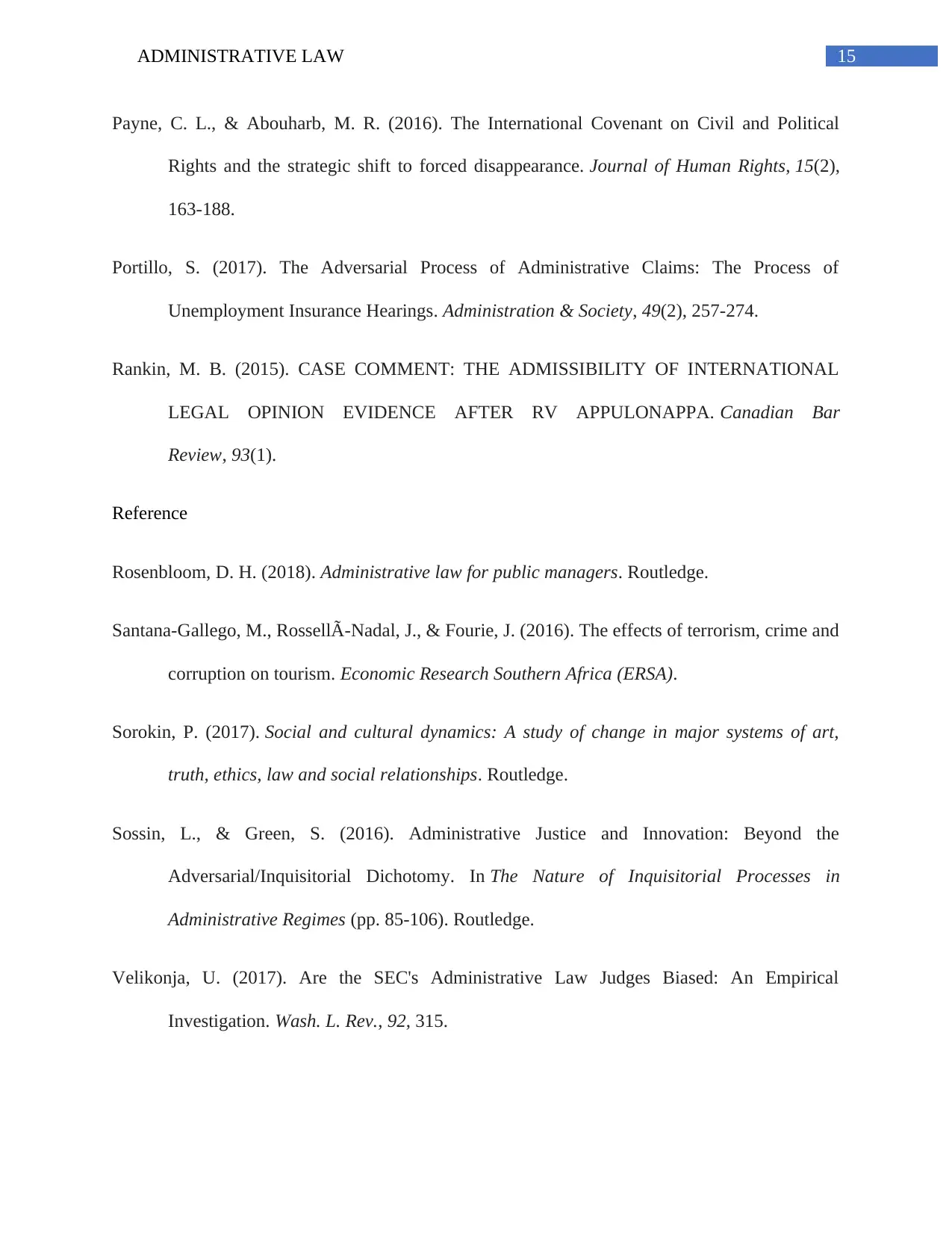
15ADMINISTRATIVE LAW
Payne, C. L., & Abouharb, M. R. (2016). The International Covenant on Civil and Political
Rights and the strategic shift to forced disappearance. Journal of Human Rights, 15(2),
163-188.
Portillo, S. (2017). The Adversarial Process of Administrative Claims: The Process of
Unemployment Insurance Hearings. Administration & Society, 49(2), 257-274.
Rankin, M. B. (2015). CASE COMMENT: THE ADMISSIBILITY OF INTERNATIONAL
LEGAL OPINION EVIDENCE AFTER RV APPULONAPPA. Canadian Bar
Review, 93(1).
Reference
Rosenbloom, D. H. (2018). Administrative law for public managers. Routledge.
Santana-Gallego, M., RossellÃ-Nadal, J., & Fourie, J. (2016). The effects of terrorism, crime and
corruption on tourism. Economic Research Southern Africa (ERSA).
Sorokin, P. (2017). Social and cultural dynamics: A study of change in major systems of art,
truth, ethics, law and social relationships. Routledge.
Sossin, L., & Green, S. (2016). Administrative Justice and Innovation: Beyond the
Adversarial/Inquisitorial Dichotomy. In The Nature of Inquisitorial Processes in
Administrative Regimes (pp. 85-106). Routledge.
Velikonja, U. (2017). Are the SEC's Administrative Law Judges Biased: An Empirical
Investigation. Wash. L. Rev., 92, 315.
Payne, C. L., & Abouharb, M. R. (2016). The International Covenant on Civil and Political
Rights and the strategic shift to forced disappearance. Journal of Human Rights, 15(2),
163-188.
Portillo, S. (2017). The Adversarial Process of Administrative Claims: The Process of
Unemployment Insurance Hearings. Administration & Society, 49(2), 257-274.
Rankin, M. B. (2015). CASE COMMENT: THE ADMISSIBILITY OF INTERNATIONAL
LEGAL OPINION EVIDENCE AFTER RV APPULONAPPA. Canadian Bar
Review, 93(1).
Reference
Rosenbloom, D. H. (2018). Administrative law for public managers. Routledge.
Santana-Gallego, M., RossellÃ-Nadal, J., & Fourie, J. (2016). The effects of terrorism, crime and
corruption on tourism. Economic Research Southern Africa (ERSA).
Sorokin, P. (2017). Social and cultural dynamics: A study of change in major systems of art,
truth, ethics, law and social relationships. Routledge.
Sossin, L., & Green, S. (2016). Administrative Justice and Innovation: Beyond the
Adversarial/Inquisitorial Dichotomy. In The Nature of Inquisitorial Processes in
Administrative Regimes (pp. 85-106). Routledge.
Velikonja, U. (2017). Are the SEC's Administrative Law Judges Biased: An Empirical
Investigation. Wash. L. Rev., 92, 315.
1 out of 16
Related Documents
Your All-in-One AI-Powered Toolkit for Academic Success.
+13062052269
info@desklib.com
Available 24*7 on WhatsApp / Email
![[object Object]](/_next/static/media/star-bottom.7253800d.svg)
Unlock your academic potential
© 2024 | Zucol Services PVT LTD | All rights reserved.


